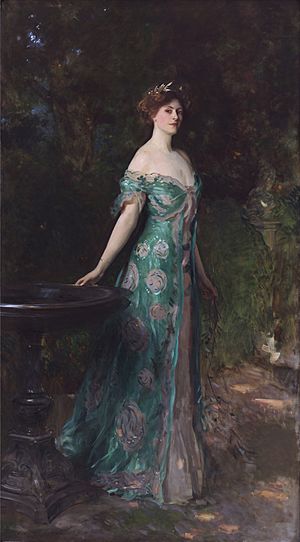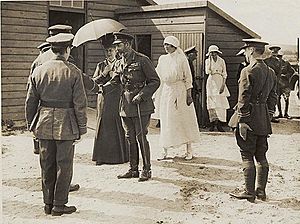Millicent Leveson-Gower, Duchess of Sutherland facts for kids

Millicent Sutherland-Leveson-Gower, Duchess of Sutherland (born Lady Millicent Fanny St. Clair-Erskine, 20 October 1867 – 20 August 1955) was a very active British lady. She was known for hosting important social events and for working to improve society. She also wrote books, edited magazines, and was a journalist and playwright. Sometimes, she used the pen name Erskine Gower.
Millicent was married three times. Her first husband was Cromartie Sutherland-Leveson-Gower, 4th Duke of Sutherland. Later, she was known as Lady Millicent Fitzgerald and then Lady Millicent Hawes. She used the name Lady Millicent Hawes when she passed away.
Contents
Early Life and Family
Millicent was born at Dysart House in Fife, Scotland. She was the oldest daughter of Robert St Clair-Erskine, 4th Earl of Rosslyn, a Scottish politician. Her sisters were Sybil Fane, Countess of Westmorland and Lady Angela Forbes.
Her mother, Blanche Adeliza Fitzroy, had been married before. This meant Millicent had half-sisters, including Daisy Greville, Countess of Warwick.
Becoming the Duchess of Sutherland
Lady Millicent St. Clair-Erskine married Cromartie Sutherland-Leveson-Gower on her 17th birthday, 20 October 1884. He was the oldest son of the 3rd Duke of Sutherland. When his father died in 1892, he became the Duke of Sutherland, and Millicent became the Duchess. He passed away in 1913.
They had four children:
- Lady Victoria Elizabeth Sutherland-Leveson-Gower (1885–1888)
- George Granville Sutherland-Leveson-Gower, 5th Duke of Sutherland (1888–1963)
- Alastair St. Clair Sutherland-Leveson-Gower (1890–1921)
- Lady Rosemary Millicent Sutherland-Leveson-Gower (1893–1930), who later married William Ward, 3rd Earl of Dudley. She died in a plane crash.
The family had several homes in Scotland, Staffordshire, and London.
Millicent became famous for hosting grand parties at their London home, Stafford House. She was also known for her work in social reform. This meant she tried to make life better for ordinary people. She was sometimes called ‘Meddlesome Millie’ because she campaigned for better working conditions. For example, she worked hard to remove harmful lead paint from Staffordshire pottery. Her efforts were successful.
She played a special role at the coronation of King Edward VII and Queen Alexandra. She was one of the four duchesses who helped carry the canopy over the Queen.
World War I Service

When World War I began in 1914, Millicent quickly organized an ambulance unit. This unit helped wounded soldiers during the siege of Namur, Belgium. She got trapped behind enemy lines in Belgium but managed to escape back to England. There, she wrote a book called Six Weeks at the War.
In October, she returned to France to manage field hospitals. She moved her unit to Roubaix in June 1918. For her brave service during the war, she received several awards. These included the French Croix de Guerre, the Belgian Royal Red Cross medal, and the British Royal Red Cross.
In October 1914, she married Major Percy Desmond Fitzgerald. After this marriage, she was known as Lady Millicent Fitzgerald.
Later Years and Legacy
Millicent married for a third time in October 1919 to Lt. Col. George Hawes. This marriage was not happy, and they divorced in 1925. She wrote a novel in 1924 called That Fool of a Woman, which was partly based on her own life.
She lived mostly in France during the 1920s and 1930s and also traveled a lot. In 1940, during World War II, she was living near Angers when Germany occupied France. She was captured but managed to escape through Spain and Portugal to the United States. She returned to Paris in 1945.
Millicent passed away in Orriule, France. Her ashes were buried at the Sutherland family cemetery at Dunrobin Castle. Her oldest son, George Sutherland-Leveson-Gower, 5th Duke of Sutherland, survived her.
The Duchess in Art
A famous portrait of Millicent from 1904 was painted by John Singer Sargent. This painting is now in Madrid.
A set of ten oil paintings by Victor Tardieu (1870–1937) show the field hospital that Millicent set up and ran in France during the summer of 1915. These paintings show the important work of nurses and women volunteers during the First World War. They are now part of the collection at the Florence Nightingale Museum.
Images for kids


